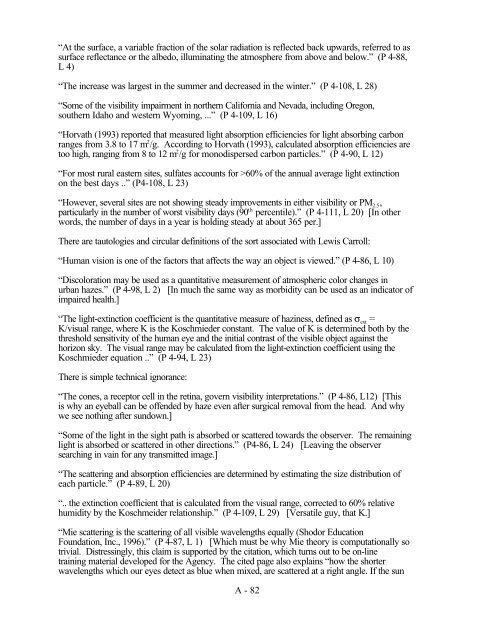Review of the Air Quality Criteria Document for Particulate Matter
Review of the Air Quality Criteria Document for Particulate Matter
Review of the Air Quality Criteria Document for Particulate Matter
- No tags were found...
Create successful ePaper yourself
Turn your PDF publications into a flip-book with our unique Google optimized e-Paper software.
“At <strong>the</strong> surface, a variable fraction <strong>of</strong> <strong>the</strong> solar radiation is reflected back upwards, referred to assurface reflectance or <strong>the</strong> albedo, illuminating <strong>the</strong> atmosphere from above and below.” (P 4-88,L 4)“The increase was largest in <strong>the</strong> summer and decreased in <strong>the</strong> winter.” (P 4-108, L 28)“Some <strong>of</strong> <strong>the</strong> visibility impairment in nor<strong>the</strong>rn Cali<strong>for</strong>nia and Nevada, including Oregon,sou<strong>the</strong>rn Idaho and western Wyoming, ...” (P 4-109, L 16)“Horvath (1993) reported that measured light absorption efficiencies <strong>for</strong> light absorbing carbonranges from 3.8 to 17 m 2 /g. According to Horvath (1993), calculated absorption efficiencies aretoo high, ranging from 8 to 12 m 2 /g <strong>for</strong> monodispersed carbon particles.” (P 4-90, L 12)“For most rural eastern sites, sulfates accounts <strong>for</strong> >60% <strong>of</strong> <strong>the</strong> annual average light extinctionon <strong>the</strong> best days ..” (P4-108, L 23)“However, several sites are not showing steady improvements in ei<strong>the</strong>r visibility or PM 2.5 ,particularly in <strong>the</strong> number <strong>of</strong> worst visibility days (90 th percentile).” (P 4-111, L 20) [In o<strong>the</strong>rwords, <strong>the</strong> number <strong>of</strong> days in a year is holding steady at about 365 per.]There are tautologies and circular definitions <strong>of</strong> <strong>the</strong> sort associated with Lewis Carroll:“Human vision is one <strong>of</strong> <strong>the</strong> factors that affects <strong>the</strong> way an object is viewed.” (P 4-86, L 10)“Discoloration may be used as a quantitative measurement <strong>of</strong> atmospheric color changes inurban hazes.” (P 4-98, L 2) [In much <strong>the</strong> same way as morbidity can be used as an indicator <strong>of</strong>impaired health.]“The light-extinction coefficient is <strong>the</strong> quantitative measure <strong>of</strong> haziness, defined as σ ext =K/visual range, where K is <strong>the</strong> Koschmieder constant. The value <strong>of</strong> K is determined both by <strong>the</strong>threshold sensitivity <strong>of</strong> <strong>the</strong> human eye and <strong>the</strong> initial contrast <strong>of</strong> <strong>the</strong> visible object against <strong>the</strong>horizon sky. The visual range may be calculated from <strong>the</strong> light-extinction coefficient using <strong>the</strong>Koschmieder equation ..” (P 4-94, L 23)There is simple technical ignorance:“The cones, a receptor cell in <strong>the</strong> retina, govern visibility interpretations.” (P 4-86, L12) [Thisis why an eyeball can be <strong>of</strong>fended by haze even after surgical removal from <strong>the</strong> head. And whywe see nothing after sundown.]“Some <strong>of</strong> <strong>the</strong> light in <strong>the</strong> sight path is absorbed or scattered towards <strong>the</strong> observer. The remaininglight is absorbed or scattered in o<strong>the</strong>r directions.” (P4-86, L 24) [Leaving <strong>the</strong> observersearching in vain <strong>for</strong> any transmitted image.]“The scattering and absorption efficiencies are determined by estimating <strong>the</strong> size distribution <strong>of</strong>each particle.” (P 4-89, L 20)“.. <strong>the</strong> extinction coefficient that is calculated from <strong>the</strong> visual range, corrected to 60% relativehumidity by <strong>the</strong> Koschmeider relationship.” (P 4-109, L 29) [Versatile guy, that K.]“Mie scattering is <strong>the</strong> scattering <strong>of</strong> all visible wavelengths equally (Shodor EducationFoundation, Inc., 1996).” (P 4-87, L 1) [Which must be why Mie <strong>the</strong>ory is computationally sotrivial. Distressingly, this claim is supported by <strong>the</strong> citation, which turns out to be on-linetraining material developed <strong>for</strong> <strong>the</strong> Agency. The cited page also explains “how <strong>the</strong> shorterwavelengths which our eyes detect as blue when mixed, are scattered at a right angle. If <strong>the</strong> sunA - 82
















